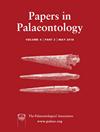Two almost‐forgotten Trypanites ichnospecies names for the most common Palaeozoic macroboring
IF 2.3
2区 地球科学
Q1 PALEONTOLOGY
引用次数: 1
Abstract
Trypanites is the most common macroboring with a global occurrence throughout the Phanerozoic and is the eponym of the Trypanites ichnofacies. It has great value for the recognition of discontinuity and hiatal surfaces on top of carbonate hardgrounds. Four ichnospecies of this ichnogenus are currently regarded as valid, while a characteristic fifth form from the early Palaeozoic is frequently reported in open nomenclature. The latter commonly occurs in lithic hardgrounds and skeletal hard substrates (such as stromatoporoids, bryozoans and corals) in Ordovician and Silurian carbonates of the Baltic region. A review of the old literature found that this ichnospecies has previously been introduced twice, as Trypanites sozialis Eisenack from a Silurian erratic boulder found on the Sambia Peninsula near Kaliningrad (now Russia), and as T. keilaensis Orviku from the Ordovician of Estonia. Both ichnospecies became forgotten names for unknown reasons. A morphometric analysis of the type material and topotype specimens indicates gradational transitions between both ichnospecies, rendering T. sozialis as the senior synonym of T. keilaensis. A lectotype from the type series of both ichnospecies is defined and additional material from Ordovician and Silurian carbonates of Estonia and Russia is described and illustrated to show the morphological and morphometric variation of this important bioerosion trace fossil. To enable interspecies comparison, a lectotype of the type ichnospecies of Trypanites, T. weisei Mägdefrau, is selected. Trypanites sozialis is a common boring in Cambrian to Devonian hardgrounds and occurs on the palaeocontinents of Baltica, Laurentia and Gondwana.两个几乎被遗忘的锥虫,古生代最常见的大孔虫
锥虫岩是最常见的大钻孔,在显生宙全球都有分布,是锥虫岩岩相的代名词。它对碳酸盐硬岩顶部的不连续面和裂孔面识别具有重要价值。该鱼属的四种目前被认为是有效的,而早期古生代的第五种特征在公开命名中经常被报道。后者通常出现在波罗的海地区奥陶系和志留系碳酸盐岩中的岩屑硬地层和骨骼硬基质(如层孔虫、苔藓虫和珊瑚)中。对旧文献的回顾发现,这种鱼种以前曾被引入过两次,分别是来自加里宁格勒附近(现俄罗斯)的Sambia半岛上发现的志留纪不稳定巨石的锥虫(Trypanites sozialis Eisenack),以及来自爱沙尼亚奥塔纪的T. keilaensis Orviku。由于未知的原因,这两种鱼类都被遗忘了。对模式材料和地形模式标本的形态计量学分析表明,这两种鱼种之间存在着等级过渡,表明社会鳞鱼是凯拉鳞鱼的高级同义种。定义了两种鱼种类型系列中的一种类型,并描述和说明了来自爱沙尼亚和俄罗斯奥陶系和志留系碳酸盐岩的额外材料,以显示这一重要的生物侵蚀痕迹化石的形态和形态测量变化。为了进行种间比较,选择了锥虫的一种卵形虫,T. weisei Mägdefrau。社会锥虫是寒武纪至泥盆纪硬地中常见的一种钻孔动物,分布在波罗的海、劳伦西亚和冈瓦纳古大陆。
本文章由计算机程序翻译,如有差异,请以英文原文为准。
求助全文
约1分钟内获得全文
求助全文
来源期刊

Papers in Palaeontology
PALEONTOLOGY-
CiteScore
4.50
自引率
4.30%
发文量
55
期刊介绍:
Papers in Palaeontology is the successor to Special Papers in Palaeontology and a journal of the Palaeontological Association (www.palass.org). The journal is devoted to the publication of papers that document the diversity of past life and its distribution in time and space.
Papers in Palaeontology is devoted to the publication of papers that document the diversity of past life and its distribution in time and space. As a sister publication to Palaeontology its focus is on descriptive research, including the descriptions of new taxa, systematic revisions of higher taxa, detailed biostratigraphical and biogeographical documentation, and descriptions of floras and faunas from specific localities or regions. Most contributions are expected to be less than 30 pp long but longer contributions will be considered if the material merits it, including single topic parts.
The journal publishes a wide variety of papers on palaeontological topics covering:
palaeozoology,
palaeobotany,
systematic studies,
palaeoecology,
micropalaeontology,
palaeobiogeography,
functional morphology,
stratigraphy,
taxonomy,
taphonomy,
palaeoenvironmental reconstruction,
palaeoclimate analysis,
biomineralization studies.
 求助内容:
求助内容: 应助结果提醒方式:
应助结果提醒方式:


